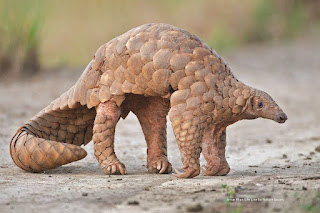This is a pangolin. It is estimated that in two years they will be extinct in the wild. I was inspired to make this post by a WWF man in London, he explained to me about how all the plushes of the animals on the stall are estimated to be in history books within the next 10 years. This was very upsetting for me as they’re such a great animal.
There is a charity called SavePangolins.org which is very informative on these gentle creatures. I will leave links to WWF and SavePangolins at the end of this post. Information is taken from Savepangolins.
There are 8 types of Pangolin, and they are all located in Asia or Africa. All species are Vulnerable or endangered, with the Chinese and Sudan Pangolins being critically endangered. Despite being insectevores, they are more closely related to the Carnivora order (cats, dogs, bear) than the Xenathrans (anteaters, sloths).
They eat insects and termites only with their very long and sticky tongues. Each species can vary in size, some weighing in at 1.6kg while some are much heavier at 33kg. All species have overlaping scales made of keritin, the same thing as finger nails, for protective purposes. When they feel threatened, they curl into a ball that no predetor can get through. These scales are continuously growing like hair but are kept at a reasonable size by digging to get to termites and ants. The underbelly of a Pangolin is covered in a thin layer of sparse fur. You can tell the Asian and African Pangolins apart by the fact that the Asian ones have bristles between their scales.
Pangolins do not have teeth, only their tongue. They have poor eyesight, but terrific noses to find termite mounds. Pangolin tongues are stored in the chest cavity when not in use due to their length, they are attached at the pelvis and when extended can be as long as the full length of the animal itself.
Pangolins are the most trafficked animal, in the past ten years over 1 million have been illegally traded. They are used for medicines and food mostly. Their scales are made into a paste/dust and are used to treat things from lactation to epilepsy. None of the things they are used to cure or aid have any scientific backing or evidence. Foetus' are used in soups, which is thought to improve a mans sperm count. Once again, there is no evidence for this.
I'm sure you're asking yourself how you can help these creatures. Well, the kind people at SavePangolins have a donation button and a shop where all profits go to saving the animals. The link to this can be found here. Obviously, WWF also accept donations as well. They are both wonderful charities.
I hope you learned something today and give some money to help save these amazing animals. No amount is too small or too much.
-Dari
There is a charity called SavePangolins.org which is very informative on these gentle creatures. I will leave links to WWF and SavePangolins at the end of this post. Information is taken from Savepangolins.
There are 8 types of Pangolin, and they are all located in Asia or Africa. All species are Vulnerable or endangered, with the Chinese and Sudan Pangolins being critically endangered. Despite being insectevores, they are more closely related to the Carnivora order (cats, dogs, bear) than the Xenathrans (anteaters, sloths).
They eat insects and termites only with their very long and sticky tongues. Each species can vary in size, some weighing in at 1.6kg while some are much heavier at 33kg. All species have overlaping scales made of keritin, the same thing as finger nails, for protective purposes. When they feel threatened, they curl into a ball that no predetor can get through. These scales are continuously growing like hair but are kept at a reasonable size by digging to get to termites and ants. The underbelly of a Pangolin is covered in a thin layer of sparse fur. You can tell the Asian and African Pangolins apart by the fact that the Asian ones have bristles between their scales.
Pangolins do not have teeth, only their tongue. They have poor eyesight, but terrific noses to find termite mounds. Pangolin tongues are stored in the chest cavity when not in use due to their length, they are attached at the pelvis and when extended can be as long as the full length of the animal itself.
Pangolins are the most trafficked animal, in the past ten years over 1 million have been illegally traded. They are used for medicines and food mostly. Their scales are made into a paste/dust and are used to treat things from lactation to epilepsy. None of the things they are used to cure or aid have any scientific backing or evidence. Foetus' are used in soups, which is thought to improve a mans sperm count. Once again, there is no evidence for this.
I'm sure you're asking yourself how you can help these creatures. Well, the kind people at SavePangolins have a donation button and a shop where all profits go to saving the animals. The link to this can be found here. Obviously, WWF also accept donations as well. They are both wonderful charities.
I hope you learned something today and give some money to help save these amazing animals. No amount is too small or too much.
-Dari

Comments
Post a Comment